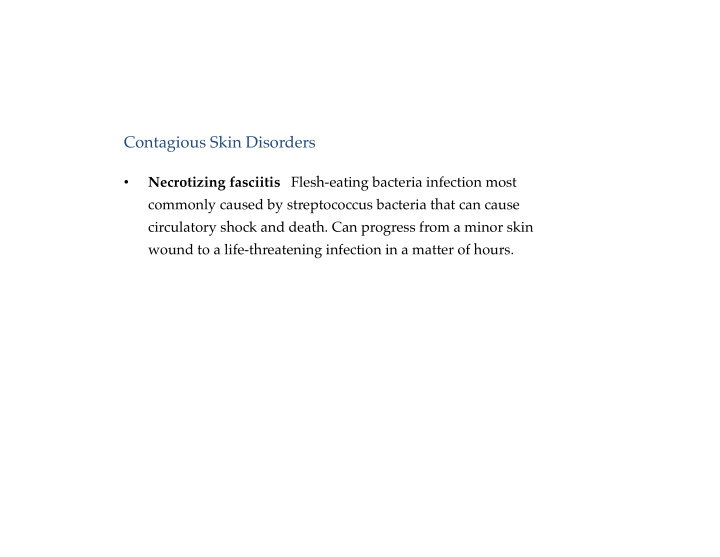



Contagious Skin Disorders Necrotizing fasciitis Flesh-eating bacteria infection most • commonly caused by streptococcus bacteria that can cause circulatory shock and death. Can progress from a minor skin wound to a life-threatening infection in a matter of hours. �
Contagious Skin Disorders Warts Small, benign growths caused by varieties of human papillomavirus (HPV) that invade kerationcytes deep in the stratum germinativum of the skin and some mucous membranes. Locally contraindicated. �
Contagious Skin Disorders • Common warts (AKA: verruca vulgaris) Hard, flaky nodules on the hands, knees, and elbows that vary in size. �
Contagious Skin Disorders Plantar warts (AKA: myrmecia) Warts on the soles of the feet that • protrude and can be easily mistaken for a callus. � Cystic warts Warts on the soles of the feet that are smooth and • soft. �
Contagious Skin Disorders Plane warts (AKA: flat warts) Small, brown, smooth warts. • Commonly found on the hands, face, and shins and may be spread during shaving. � • Genital warts Sexually transmitted infection caused by several varieties of HPV. Most come and go with no symptoms, but others may trigger cellular activity leading to cervical cancer. �
Non-Contagious Inflammatory Skin Disorders Acne rosacea Idiopathic chronic inflammatory condition involving facial skin and eyes. Massage may exacerbate this condition. �
Non-Contagious Inflammatory Skin Disorders Acne vulgaris Small, localized skin lesions that usually affecting sebaceous glands on the face, neck, and upper back. Closely associated with adolescence, but can persist well into adulthood. Locally contraindicates massage. �
Non-Contagious Inflammatory Skin Disorders Dermatitis Umbrella term meaning non-infectious skin inflammation. �
Non-Contagious Inflammatory Skin Disorders Eczema Non-contagious skin rash brought about by a systemic hypersensitivity reaction. Commonly seen along with allergic sinusitis (hay fever) and asthma. �
Non-Contagious Inflammatory Skin Disorders Contact dermatitis Skin inflammation caused by an externally applied irritant or allergen such as poison ivy, metals, soaps, dyes, or latex. �
Non-Contagious Inflammatory Skin Disorders Contact dermatitis Skin inflammation caused by an externally applied irritant or allergen such as poison ivy, metals, soaps, dyes, or latex. �
Neoplastic Skin Disorders ¡ Seborrheic keratosis (SK) Common non-contagious condition involving single or multiple benign skin growths that usually affect mature adults. Local caution if they itch or bleed. May be irritated by friction. �
Neoplastic Skin Disorders Skin cancer Group of diseases involving potentially malignant changes in � epidermal cells. Undiagnosed skin lesions are locally contraindicated. � • Basal cell carcinoma � • Squamous cell carcinoma � • Melanoma �
Neoplastic Skin Disorders Basal cell carcinoma (BCC) Most common type of skin cancer. Slow-growing tumor of stratum germinativum cells on the face or head. �
Neoplastic Skin Disorders Basal cell carcinoma (BCC) Most common type of skin cancer. Slow-growing tumor of stratum germinativum cells on the face or head. �
Neoplastic Skin Disorders Basal cell carcinoma (BCC) Most common type of skin cancer. Slow-growing tumor of stratum germinativum cells on the face or head. �
Neoplastic Skin Disorders Squamous cell carcinoma Skin cancer that arises in keratinocytes that are superficial to the stratum germinativum. �
Neoplastic Skin Disorders Squamous cell carcinoma Skin cancer that arises in keratinocytes that are superficial to the stratum germinativum. �
Neoplastic Skin Disorders Melanoma Cancer of the pigment cells deep in the epidermis. Metastasizes readily and is the leading cause of death by skin cancer. �
Neoplastic Skin Disorders Melanoma Cancer of the pigment cells deep in the epidermis. Metastasizes readily and is the leading cause of death by skin cancer. �
Neoplastic Skin Disorders Melanoma Cancer of the pigment cells deep in the epidermis. Metastasizes readily and is the leading cause of death by skin cancer. �
Neoplastic Skin Disorders Melanoma Cancer of the pigment cells deep in the epidermis. Metastasizes readily and is the leading cause of death by skin cancer. �
Neoplastic Skin Disorders ABCs of recognizing malignant melanoma: � » Asymmetrical: irregular in shape � » Border: inconsistent � » Color: multicolored. � » Diameter: greater than 6mm (1/4 of an inch) � » Elevated or Evolving �
Skin Injuries Burns Damage to skin caused by heat, radiation, corrosive chemicals, and electricity. Contraindicate massage due to risk of infection and pain. � • First degree or superficial burn � • Second degree or partial thickness burn � • Third degree or full thickness burn �
Skin Injuries First degree or superficial burn Burn involving mild but painful • irritation of the superficial epidermis. Red without blisters. Example: sunburn. �
Skin Injuries Second degree or partial thickness burn Burn involving damage • to deeper layers of the epidermis. Redness, blisters, and a permanent scar. �
Skin Injuries Third degree or full thickness burn Burn that penetrates down to • the dermis or deeper damaging glands, hair shafts, nerve endings, and muscle tissues. �
Skin Injuries Decubitus ulcer (AKA: bedsores, or pressure sores) Lesions caused by impaired circulation to the skin because of external pressure. Leads to � localized cell death. High risk of secondary infection contraindicates massage. �
Skin Injuries Scar tissue Development of new cells and extracellular matrix after an injury, infection, or surgery. Contraindicates massage if still injured and not yet healed. �
29a Pathology - Integumentary System ¡
Recommend
More recommend